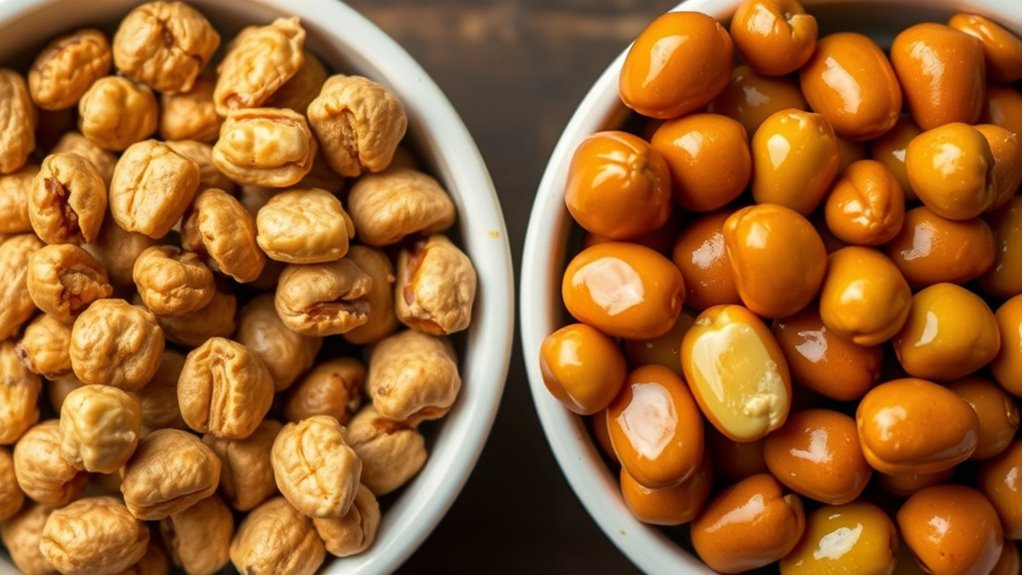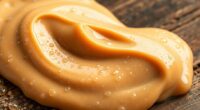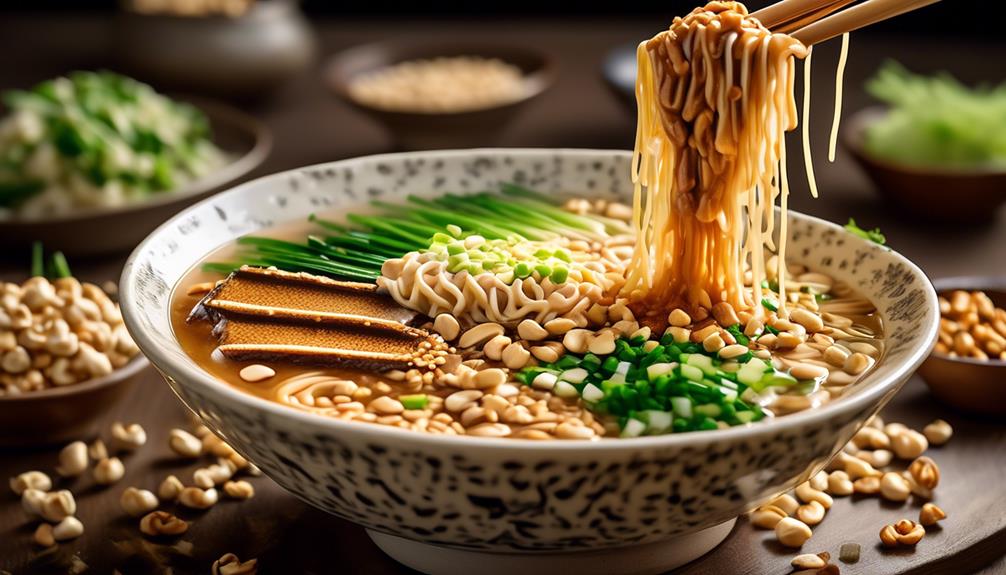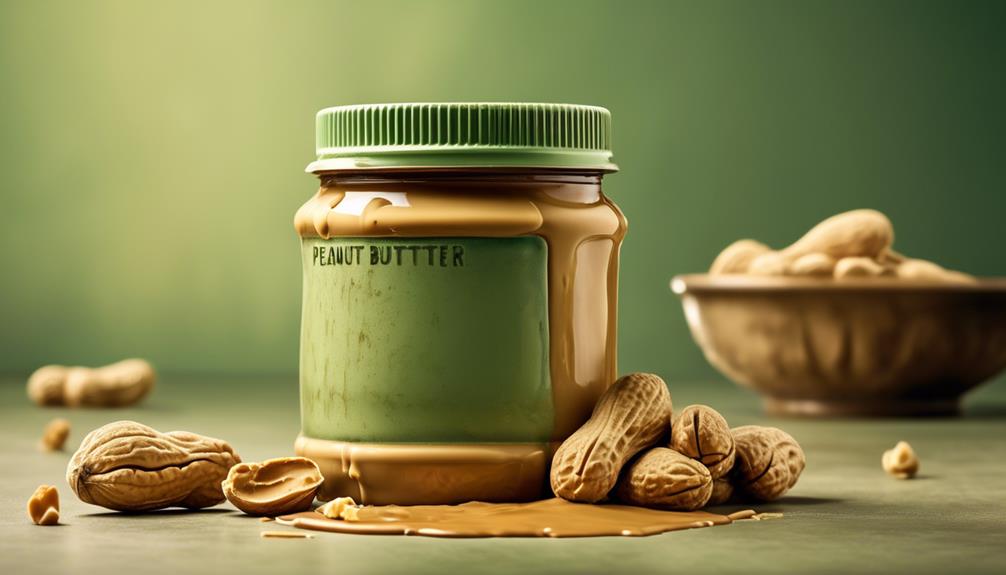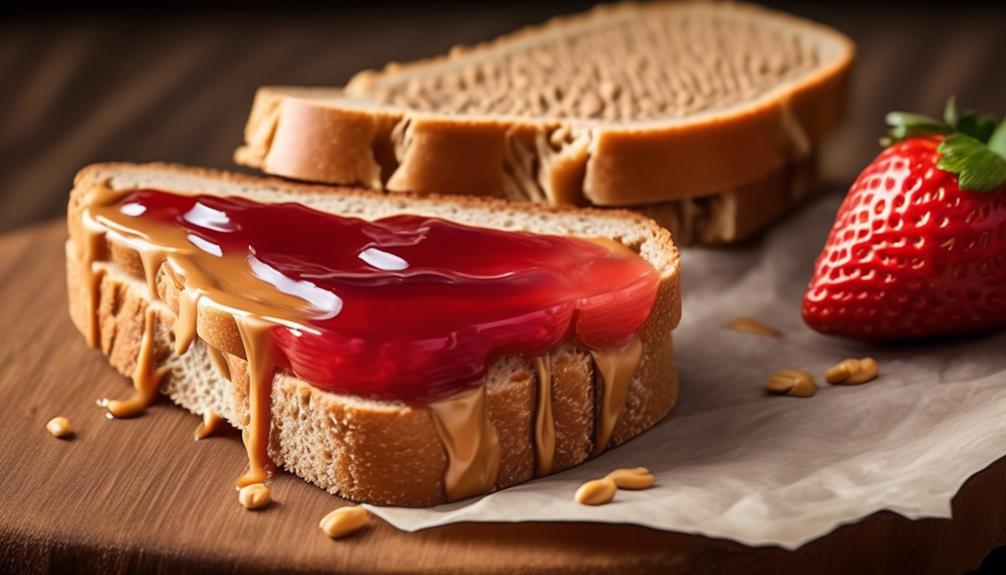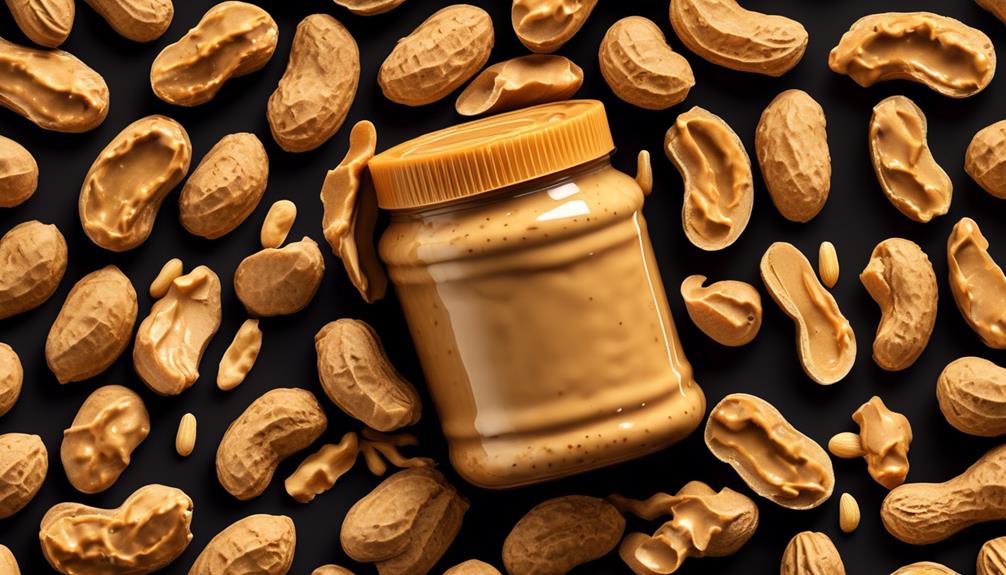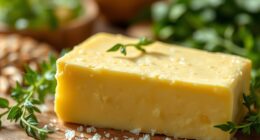Dry roasting peanuts enhances their natural, subtle butter-like flavor, producing a toasted aroma and firmer texture through direct heat, while oil roasting adds richness and creaminess, amplifying buttery notes with even heat distribution. The oil helps develop deeper, indulgent flavors and a smoother mouthfeel, but may slightly mellow the aroma. To discover how each method influences flavor differences and which suits your preference best, explore further insights ahead.
Key Takeaways
- Oil roasting enhances butter-like flavors through better heat transfer and oil absorption, intensifying richness and creaminess.
- Dry roasting preserves subtle natural butter notes, resulting in a more delicate and pure nutty flavor profile.
- Oil roasting produces a more indulgent, smooth flavor with deeper caramelization, while dry roasting emphasizes toasted, roasted butter nuances.
- The moist environment of oil roasting amplifies buttery aromas, though generally less intense than the direct heat aroma of dry roasting.
- Butter flavor development is influenced by fat content and chemical reactions; oil roasting tends to produce stronger butter-like notes overall.
The Basics of Roasting Methods for Peanuts
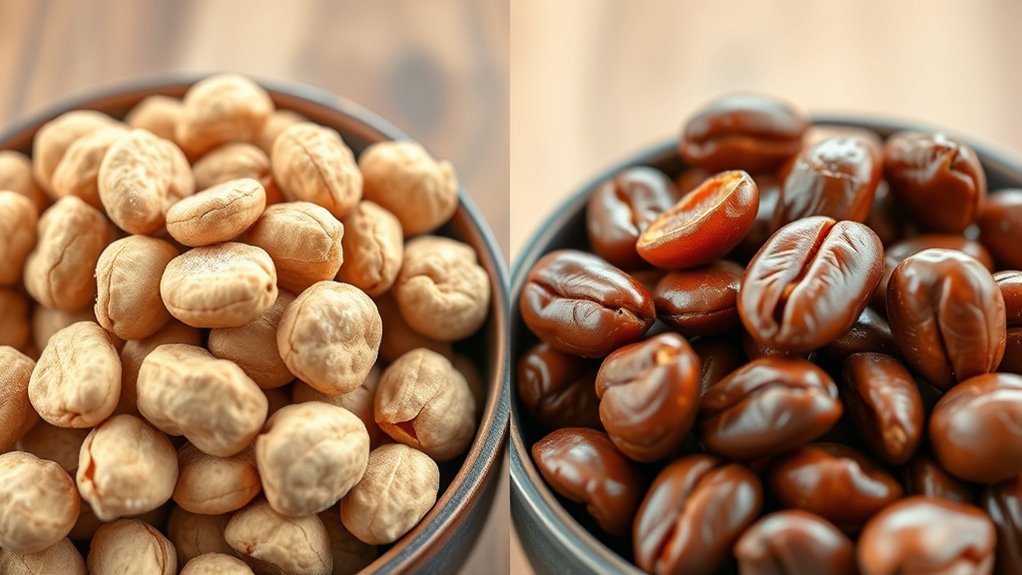
Roasting peanuts enhances their flavor and texture, and understanding the basic methods can help you choose the best approach. Nut roasting involves either dry roasting or oil roasting, each affecting flavor preservation differently. Dry roasting uses direct heat, often in an oven or skillet, which helps maintain the nut’s natural taste while developing a toasted aroma. Oil roasting, on the other hand, involves cooking peanuts in hot oil, which can add richness but might mask subtle flavors. To safeguard the natural flavor, dry roasting is typically preferred because it minimizes added ingredients and allows the nut’s inherent qualities to shine. Additionally, color accuracy in the roasting process can influence the final appearance and appeal of the peanuts. Whichever method you choose, controlling temperature and timing is essential to avoid burning and ensure ideal flavor preservation.
How Dry Roasting Alters Peanut Flavor and Texture

Dry roasting transforms peanuts by intensifying their natural flavors and producing a distinctive toasted aroma. This process enhances the peanut protein’s Maillard reactions, creating deeper flavor complexity. As you increase roasting temperature, the texture becomes crunchier, and the nutty aroma intensifies. However, higher temperatures can also reduce moisture, affecting freshness. Here’s a quick look at how different roasting levels impact flavor and texture:
| Temperature Range | Flavor Profile | Texture |
|---|---|---|
| Low (300°F) | Mild, nutty | Slightly softer |
| Medium (350°F) | Toasted, richer aroma | Firm, crunchy |
| High (400°F) | Deep, smoky flavor | Very crunchy |
| Over-roasted | Bitter, burnt notes | Hard, dry |
The Impact of Oil Roasting on Peanut Richness
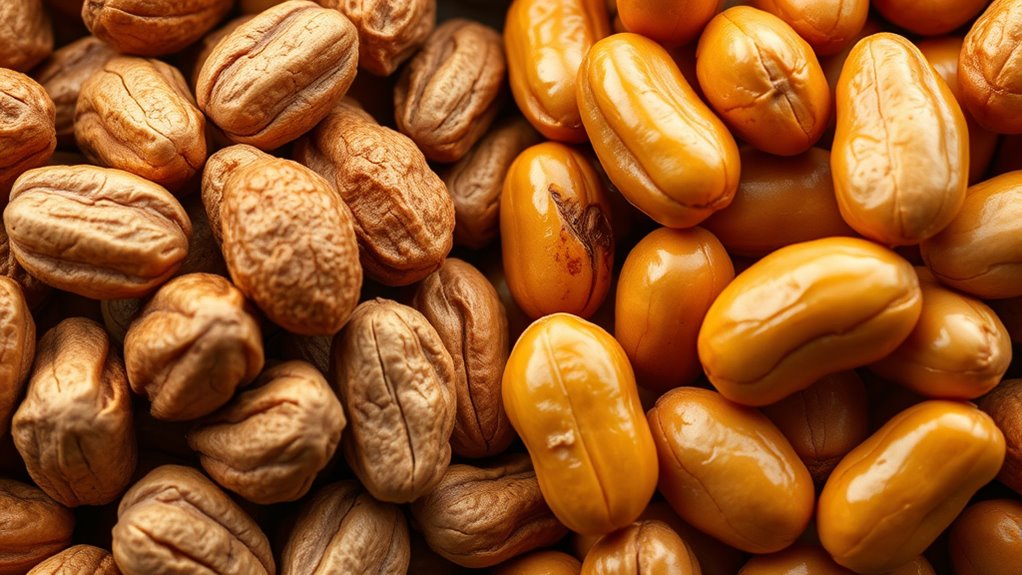
When peanuts are oil roasted, the addition of oil during the process enhances their overall richness and mouthfeel. This method often involves careful peanut shelling beforehand to guarantee even coating. The roasting temperature plays a vital role; higher temperatures develop deeper flavors and intensify the peanut’s natural oils, boosting richness. Oil coating helps distribute heat more evenly, resulting in a more uniform roast that emphasizes the peanut’s full-bodied flavor. Unlike dry roasting, where heat directly contacts the shell, oil acts as a buffer, preserving moisture and creating a smoother, more indulgent taste. As a result, oil-roasted peanuts tend to feel richer and more decadent, appealing to those seeking a more robust, buttery experience in every bite. Incorporating aesthetic wall organization techniques can also help showcase these flavorful snacks in an attractive and accessible manner.
Butter-Like Notes: Which Method Enhances This Flavor?

If you’re looking for peanuts with a rich, buttery flavor, oil roasting often brings out those notes more vividly. On the other hand, dry roasting tends to preserve the peanuts’ natural, subtle flavors. Which method do you think offers the creaminess you prefer? Additionally, oil roasting can sometimes enhance flavor development, making the peanuts taste more indulgent.
Oil Roasting Enhances Butteriness
Oil roasting tends to amplify the buttery, rich notes in peanuts, making them more pronounced and appealing. During peanut shelling, selecting quality peanuts guarantees consistent flavor development. The roasting equipment used in oil roasting allows for even heat distribution, which helps extract and enhance butter-like flavors. The oil acts as a medium that transfers heat efficiently, intensifying the nut’s natural richness. Because oil roasting keeps peanuts moist and prevents excessive drying, the butteriness remains prominent. This method also promotes a smoother, more uniform flavor profile, highlighting buttery and caramel-like notes. Additionally, controlling temperature during oil roasting is crucial for achieving optimal flavor extraction without burning the nuts. If you’re aiming for a deep, buttery flavor, oil roasting’s controlled environment and equipment choice make it the ideal method for enhancing those rich, butter-like qualities in your peanuts.
Dry Roasting Preserves Natural Notes
Dry roasting is often preferred if you want to preserve the peanuts’ natural, subtle flavor notes, including their butter-like qualities. This method maintains the integrity of the peanuts’ original flavor because it involves minimal added ingredients, unlike oil roasting. Proper peanut storage before roasting ensures the nuts stay fresh and free from moisture, which helps retain their delicate notes. Using quality roasting equipment, such as a well-calibrated oven or dry roasting pan, allows for even heat distribution without introducing flavors from oils or fats. Because dry roasting doesn’t mask the peanuts’ natural oils, their inherent butter-like aroma and taste are more pronounced. This technique highlights the peanuts’ authentic profile, making it ideal if you want to enjoy their pure, natural essence. Additionally, traditional roasting methods can influence the final flavor and aroma, emphasizing the importance of choosing the right technique to preserve the butter-like notes.
Chemical Changes During Dry and Oil Roasting

During roasting, you’ll notice chemical changes like the Maillard reaction, which develops flavor and color. The oil content in peanuts influences these reactions and the resulting aroma. Understanding how flavor compounds form can help you choose the best roasting method for your taste preferences. Additionally, the presence of natural oils can affect flavor retention and overall aroma development during roasting.
Maillard Reaction Impact
The Maillard reaction, a complex chemical process responsible for browning and flavor development, occurs differently in dry-roast and oil-roast peanuts due to their distinct heating environments. In dry roasting, higher temperatures and dry air promote more intense Maillard reactions, leading to richer flavor enhancement and deeper browning. Oil roasting, with its moist heat, moderates this reaction, preserving aroma and subtle flavors. Here’s how the reaction varies:
| Roasting Method | Impact on Flavor | Effect on Aroma | Browning Intensity |
|---|---|---|---|
| Dry-Roast | Strong flavor development | Intense aroma | Darker color |
| Oil-Roast | Mild flavor | Preserved aroma | Lighter color |
| Combination | Balanced effects | Complex aroma | Moderate browning |
Understanding these differences helps you choose the roasting method that best enhances flavor and preserves aroma. Additionally, the Maillard reaction is influenced by factors such as moisture content and temperature, which vary between roasting methods.
Oil Content Effects
Roasting peanuts causes significant chemical changes in their oil content, which directly influences flavor, texture, and aroma. During oil roasting, peanuts absorb additional peanut oil, enhancing their moistness and richness. The degree of peanut oil absorption depends on roasting temperature effects; higher temperatures promote more oil uptake, leading to a deeper, butter-like flavor. Oil-roasted peanuts typically retain more oil, resulting in a smoother mouthfeel and increased tenderness. Conversely, dry roasting yields less oil absorption, producing a crisper texture. The chemical changes in oil content also impact how flavors develop and intensify, making oil-roasted peanuts richer and more cohesive in taste. Controlling roasting temperature is essential to manage oil absorption levels and achieve the desired flavor profile. Additionally, preppy dog names can be used as a fun analogy for selecting the right roasting method, emphasizing the importance of choosing styles that match your preferences.
Flavor Compound Formation
Dry and oil roasting trigger distinct chemical reactions that shape the peanuts’ flavor profiles. During dry roasting, the high heat promotes Maillard reactions, which enhance sweetness and lead to rich color development. These reactions produce complex flavor compounds that give dry-roasted peanuts their characteristic toasted aroma. Oil roasting, on the other hand, accelerates these processes by conducting heat more evenly and quickly, resulting in deeper color and intensified flavor. The presence of oil also influences the formation of specific aroma compounds, contributing to a butter-like flavor. Both methods involve the formation of volatile compounds that impact taste and aroma. Ultimately, the chemical changes during roasting define the unique flavor qualities, with dry roasting emphasizing sweetness and color, while oil roasting enhances richness and depth.
The Role of Fat Content in Flavor Development
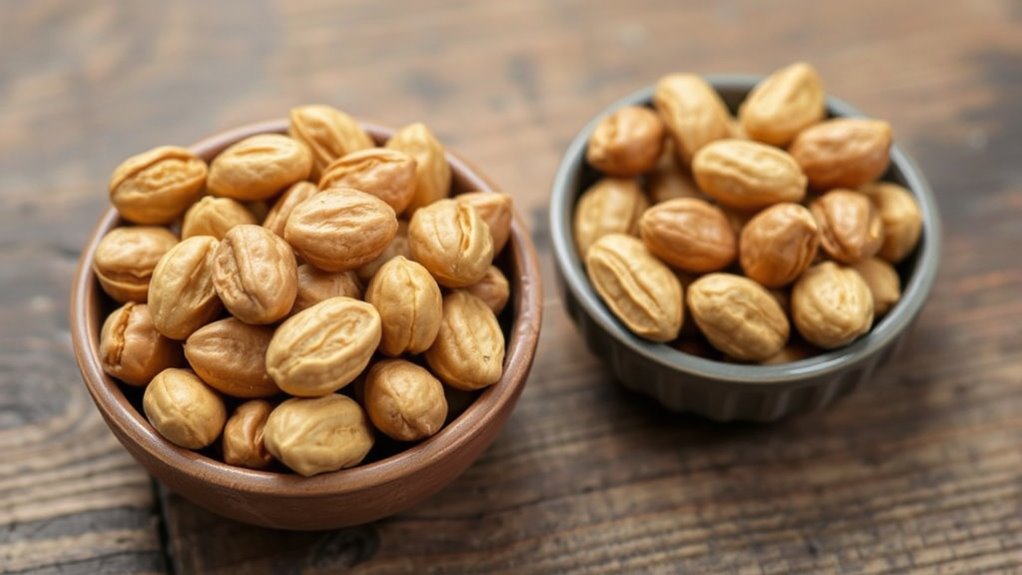
Fat content plays a crucial role in how peanuts develop their flavor during roasting. It influences the sweetness contrast, as higher fat levels can mellow the natural nutty sweetness, creating a richer, butter-like flavor. Oil-roasted peanuts typically have more fat, which enhances this creamy texture and deepens flavor complexity. Additionally, fat impacts nutritional variation, since oil-roasted peanuts often contain added oils or higher fat content, affecting health considerations. The fat acts as a carrier for flavor compounds, intensifying the overall taste experience. Understanding the fat content helps you appreciate how different roasting methods influence flavor development. Advanced Techniques in roasting can also modify how fats are released and interact with other flavor compounds, further shaping the final taste.
Comparing Aroma Profiles of Dry- and Oil-Roasted Peanuts

You’ll notice that dry- and oil-roasted peanuts differ in aroma intensity, shaping your overall experience. The nutty flavors also vary, with each method highlighting different nuances. Exploring these aroma profiles helps you choose the perfect peanut for your taste preferences. Additionally, automation in food production techniques can influence flavor development and consistency.
Aroma Intensity Levels
While both dry-roast and oil-roast peanuts develop rich aromatic profiles, their aroma intensity levels can vary considerably. Dry-roast peanuts often produce a more pronounced aroma because the process involves direct heat, which intensifies the scent during peanut shelling. The roasting equipment used also influences aroma strength; traditional open roasters tend to create more intense smells compared to modern, enclosed machines. Oil-roasted peanuts usually have a subtler aroma, as the oil moderates heat transfer and disperses scent differently. The presence of oil can mellow the aroma intensity, making it less sharp but more evenly distributed. Your choice of roasting method and equipment impacts not just flavor but also how strong the peanut aroma becomes during processing.
Nutty Flavor Nuances
Dry-roast peanuts develop a deeply nutty flavor with a pronounced, toasted complexity that highlights their natural richness. You’ll notice sweet undertones that add a subtle warmth, balancing the earthier hints of the roasted nuts. The aroma profile of dry roasting emphasizes these nuanced layers, giving the peanuts a more layered, complex scent. In contrast, oil-roasted peanuts tend to have a milder, more uniform aroma, with less pronounced nutty nuances. The dry roasting process enhances the natural sweetness and earthy qualities, making the aroma more vibrant and inviting. When comparing the two, you’ll find dry-roasted peanuts offer a richer, more textured nutty profile, with distinct sweet and earthy notes that appeal to those seeking a more robust flavor experience.
Texture and Mouthfeel: Does Roasting Method Matter?

Does the roasting method influence the texture and mouthfeel of peanuts? Absolutely. Dry roasting typically produces a firmer, crunchier peanut, enhancing peanut crunch and making each bite more satisfying. Oil roasting, however, can create a slightly softer texture due to the added moisture and fat, which may impact flavor longevity and how long the crunch lasts. You’ll notice that dry-roasted peanuts often retain their crispness longer, maintaining that fresh, satisfying bite.
- Dry roasting enhances peanut crunch and preserves texture over time
- Oil roasting can soften peanuts, affecting crunch and mouthfeel
- Texture differences influence overall eating experience and flavor perception
Choosing the method impacts not just flavor but how you experience the peanut’s texture and mouthfeel.
Which Roasting Technique Is Better for a Buttery Taste?

The roasting method you choose considerably impacts the peanut’s buttery flavor. Dry roasting often enhances natural sweetness and butter-like notes because it uses higher roasting temperatures without added oils. Oil roasting can also produce a buttery flavor, but it may be subtler due to the oil’s influence. If you have a peanut allergy concern, dry roasting minimizes allergen exposure, as no oil is added.
| Roasting Technique | Butter Flavor Impact |
|---|---|
| Dry Roast | Intensifies natural buttery notes |
| Oil Roast | Slightly milder, oil influences flavor |
Choosing between them depends on the desired butteriness and allergy considerations. Higher roasting temperatures amplify buttery flavors, especially in dry roasting.
Tips for Choosing Peanuts Based on Flavor Preferences

When selecting peanuts based on flavor preferences, consider the intensity and type of taste you enjoy most. If you prefer a richer, buttery flavor, dry-roasted peanuts often have a more natural, nutty profile. For a slightly saltier, more savory taste, oil-roasted peanuts are ideal. To enhance your experience, store peanuts properly in a cool, dry place to maintain freshness and flavor. Also, think about your roasting equipment—some tools produce more uniform roasting, affecting flavor consistency.
- Choose dry-roasted for a natural, pure peanut flavor
- Opt for oil-roasted if you prefer added salt or seasoning
- Proper peanut storage preserves flavor and texture over time
Frequently Asked Questions
How Does Roasting Temperature Influence Peanut Flavor?
Roasting temperature greatly influences peanut flavor by impacting flavor development and texture variation. As you increase the temperature, the peanuts undergo Maillard reactions, enhancing their nutty, roasted flavors. Higher temps also create a crunchier texture, while lower ones preserve moisture and softness. So, adjusting the roasting temperature allows you to customize the flavor profile and texture, whether you prefer a milder or more intensely roasted taste.
Can Roasting Method Affect Peanut Allergen Levels?
Think of roasting as a delicate dance, where each step influences the outcome. Your roasting method can impact peanut allergen levels, affecting peanut allergy risk and roasting safety. Dry roasting may slightly reduce allergens through heat, but it doesn’t eliminate them. To minimize risks, verify proper roasting temperatures and times. Always handle peanuts safely, knowing that while roasting changes flavor, it’s not a foolproof way to tackle allergen concerns.
Which Roasting Method Retains More Nutritional Value?
When choosing a roasting method, consider nutrient retention and health benefits. Dry-roasting typically preserves more nutrients because it involves minimal added fats, maintaining vitamins and antioxidants. Oil-roasting, while tasty, can slightly reduce nutrient levels due to added oils and higher temperatures. For better nutrient retention and health benefits, dry-roasting is the smarter choice, helping you enjoy the full nutritional profile of peanuts while supporting your overall wellness.
Do Dry and Oil Roasted Peanuts Differ in Shelf Life?
Imagine two jars of peanuts, one dry-roasted, one oil-roasted, sitting on your shelf. Dry-roasted peanuts usually have a longer shelf stability because they contain less moisture, which helps prevent spoilage. Oil-roasted peanuts might have a shorter storage duration, as the oil can go rancid over time. So, if you’re looking for longer-lasting snacking options, dry-roasted peanuts are your best bet.
How Do Roasting Techniques Impact Peanut Oil Composition?
Roasting techniques substantially impact peanut oil composition through roasting chemistry. When you dry roast, the heat causes minimal oil alteration, preserving natural peanut oils. In contrast, oil roasting involves adding or heating with oil, which changes the peanut’s oil profile. This process can enhance flavor but may also modify the oil’s chemical structure, affecting taste and shelf life. So, your roasting method directly influences peanut oil’s flavor and stability.
Conclusion
Whether you prefer the dry roast’s pure, toasted flavor or the oil roast’s richer, buttery notes, your choice shapes your peanut experience. Consider the texture, aroma, and flavor you seek—whether it’s the crispness of dry roasting or the indulgence of oil roasting. Ultimately, your preference guides your selection, your taste buds determine the outcome, and your enjoyment depends on the method you choose. Embrace the process, savor the flavor, and enjoy your perfect peanut.
